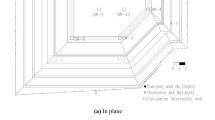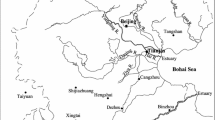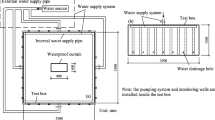Conclusions
-
1.
The methods of lowering the water table which were employed on canal structures primarily enabled us to control rather successfully the problems encountered in dewatering the foundation pits.
-
2.
In conducting operations to lower the water table at a number of sites, significant corrective action was taken on the design scheme; this was associated with the difference between the actual hydrogeologic conditions and those assumed during the planning stages. This suggests the need for increasing the volume of investigatory work for the purpose of a more complete study of the geologic profile, the seepage characteristics of the soils, and the interaction between the water-bearing levels.
-
3.
In ideal foundation pits, the fundamental difficulties are associated with the interception of the residual influx of water through the sand-impervious contact. In isolated cases, these difficulties have been surmounted by installing a deep trench backfilled with a porous material and the water removed from it by well-point installations.
Similar content being viewed by others
Additional information
Translated from Gidrotekhnicheskoe Stroitel'stvo, No. 12, pp. 3–6, December, 1975.
Rights and permissions
About this article
Cite this article
Baranov, A.I. Dewatering the foundation pits of hydraulic structures on the Dnepr-Donbass canal. Hydrotechnical Construction 9, 1129–1133 (1975). https://doi.org/10.1007/BF02380100
Issue Date:
DOI: https://doi.org/10.1007/BF02380100




